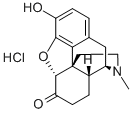| | Hydromorphone hydrochloride Basic information |
| Product Name: | Hydromorphone hydrochloride | | Synonyms: | morphinan-6-one,4,5-alpha-epoxy-3-hydroxy-17-methyl-,hydrochloride,(5’-alpha;hydromorphone hydrochloride--dea*schedule ii item;HYDROMORPHONE HYDROCHLORIDE METHANOL*SOL UTION;HYDROMORPHONE HYDROCHLORIDE OPIATE ANALG ESIC;(5α)-4,5-epoxy-3-hydroxy-17-methyl-morphinan-6-one hydrochloride;hydromorphone hydrochloride solution;HYDROMORPHONEHYDROCHLORIDE,USP;Hydromorphine hydrochloride | | CAS: | 71-68-1 | | MF: | C17H20ClNO3 | | MW: | 321.8 | | EINECS: | 200-762-6 | | Product Categories: | Chiral Reagents;Intermediates & Fine Chemicals;Pharmaceuticals | | Mol File: | 71-68-1.mol |  |
| | Hydromorphone hydrochloride Chemical Properties |
| Hazard Codes | Xn | | Risk Statements | 22 | | Safety Statements | 16-36/37-45 | | RIDADR | UN 1230 3/PG 2 | | WGK Germany | 3 | | RTECS | QD2625000 | | HazardClass | 6.1(a) | | PackingGroup | II | | HS Code | 2939110000 | | Toxicity | LD50 in mice (mg/kg): 61-96 i.v. (Buchwald, Eadie) |
| | Hydromorphone hydrochloride Usage And Synthesis |
| Description | Hydromorphone hydrochloride is a pure opioid agonist with the principal therapeutic activity of analgesia. It has an analgesic potency approximately two to eight times greater than that of morphine and has a rapid onset of action. A significant feature of the analgesia is that it can occur without loss of consciousness. | | Chemical Properties | White Solid | | Uses | Analgesic (narcotic). Preparation by electrolytic reduction of Morphine.
Controlled substance (opiate). | | Biochem/physiol Actions | Narcotic opiate analgesic; μ opioid receptor agonist. | | Clinical Use | Hydromorphone is a potent μ agonist (eight times greater than morphine) that is used to treat severe pain. It is available in intramuscular, intravenous, subcutaneous, oral, and rectal dosage forms. Like all strong μ agonists, hydromorphone is addicting and is a Schedule II drug. Hydromorphone has an oral:parenteral potency ratio of 5:1. The plasma half-lives after parenteral and oral dosage are 2.5 and 4 hours, respectively. | | Safety Profile | Poison by
subcutaneous and intravenous routes.
Experimental teratogenic effects. A
powerful analgesic. When heated to
decomposition it emits very toxic fumes of
NOx and HCl. See also MORPHINE. | | Drug interactions | Potentially hazardous interactions with other drugs
Alcohol: can cause dose dumping with sustained
release preparations.
Analgesics: possible opioid withdrawal effects with
buprenorphine and pentazocine.
Antidepressants: possible CNS excitation or
depression with MAOIs - avoid concomitant use
and for 2 weeks after stopping MAOI; possible
CNS excitation or depression with moclobemide;
increased sedative effects with tricyclics.
Antihistamines: increased sedative effects with
sedating antihistamines.
Antipsychotics: enhanced hypotensive and sedative
effects.
Dopaminergics: avoid with selegiline.
Nalmefene: avoid concomitant use.
Sodium oxybate: enhanced effect of sodium oxybate
- avoid. | | Metabolism | Hydromorphone undergoes extensive firstpass
metabolism. It is extensively metabolised
by glucuronidation in the liver and excreted in
the urine mainly as conjugated hydromorphone,
dihydroisomorphine, and dihydromorphine. |
| | Hydromorphone hydrochloride Preparation Products And Raw materials |
|